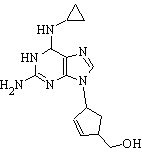Abacavir tablets are yellow, capsule-shaped, film-coated and imprinted with "GX623" on one side. The drug is also available in an oral solution.
"Approval of abacavir will offer patients another 'choice' in antiretroviral therapy, but data so far suggest that the choice is not a functionally important one; rather, it's more like the choice between a blue pill and a red one."
Tagline, 1998
"Newly approved abacavir ... promises to be one of the most potent antiretroviral agents available for treatment of HIV infection."
Treatment Issues, 1999
Also known as: ABV, 1592, abacavir sulfate
Background and description. Abacavir is a nucleoside reverse transcriptase inhibitor (NRTI). This drug is the most powerful in its class and one of the most potent antiretrovirals available. The US Food and Drug Administration (FDA) approved abacavir in December 1998. The drug is manufactured by Glaxo Wellcome. Abacavir is indicated in combination with other antiretrovirals for the treatment of HIV infection.
Guidelines classification. The Panel on Clinical Practices for the Treatment of HIV Infection classifies abacavir as an "alternative" NRTI.
Dose. The recommended dose of abacavir for adults is 300 mg (1 tablet) twice a day.
Food restrictions. Abacavir may be taken with or without food.
Storage. The tablets should be stored at a room temperature of 68 [degrees] to 77 [degrees] F; the solution should be kept at room temperature or refrigerated, but not frozen.
Side effects and toxicity. The side effects most commonly associated with abacavir therapy include nausea, vomiting, fatigue, headache, diarrhea and loss of appetite. As a class, NRTIs have been implicated in damage to mitochondrial DNA and may therefore play a role in the development of metabolic and morphologic abnormalities. The most serious side effect, however, is a hypersensitivity reaction that occurs in approximately 5% of those receiving abacavir. Symptoms of abacavir hypersensitivity usually appear within the first 6 weeks of treatment and include a skin rash or 2 or more of the following sets of symptoms: fever, nausea, vomiting, diarrhea or abdominal pain, severe tiredness, achiness or a general sense of ill-health. A recent review of cases revealed that respiratory symptoms including cough, dyspnea (shortness of breath), and pharyngitis (sore throat) occurred in approximately 20% of patients having hypersensitivity reactions. Deaths have been reported in patients receiving abacavir who were initially diagnosed with an acute respiratory disease, but were later recognized to have had hypersensitivity reactions. Patients who believe they are experiencing abacavir hypersensitivity should stop taking the drug and call their physician immediately. Those who experience hypersensitivity to abacavir must never take the drug again. Any effort to rechallenge can produce life-threatening symptoms.
Drug interactions. Abacavir is not known to have clinically significant interactions with other drugs.
Resistance and cross-resistance. Patients who have used and developed resistance to multiple NRTIs are unlikely to reduce their viral load with the use of abacavir. On the other hand, patients who have used and developed resistance to only two NRTIs may see significant reductions in viral load when abacavir is combined with other drugs. In a Glaxo Wellcome-sponsored expanded access program, which provided the drug to patients with advanced disease and few treatment options, abacavir produced a 0.5 log reduction in viral load for only 1 in 4 patients.
Clinical data. In a pivotal study of abacavir, a team of Glaxo Wellcome investigators randomized 86 patients to a regimen of zidovudine (Retrovir)/lamivudine (Epivir) and another 87 to a combination of abacavir/ zidovudine/lamivudine. Participants were required to be naive to antiretroviral therapy. The median baseline viral load among the study subjects was approximately 38,000 copies/mL, while the median baseline CD4 T cell count was approximately 450 cells/[mm.sup.3]. At the end of the first 16 weeks, which were double-blind, approximately 80% of the subjects in the 3-drug arm had undetectable viral loads (less than 400 copies/mL). Unsurprisingly, less than 40% of the subjects in the double-NRTI comparison arm had undetectable plasma viremia. By week 48, approximately 60% of the triple-therapy subjects still had undetectable viral loads; however, participants with a baseline viral load of greater than 100,000 copies/mL were much less likely than other subjects to achieve undetectable viremia with the use of abacavir. Glaxo Wellcome reports that only 6% of the subjects assigned to the 3-drug group withdrew from study for adverse events.
For those who have been heavily treated with other NRTIs, abacavir may have limited utility because of pre-existing resistance. However, for patients with limited or no NRTI experience, this nucleoside offers a potent, convenient and generally well-tolerated choice.
Patient assistance. Glaxo Wellcome provides a patient assistance program. For more information, call 800.722.9294.
COPYRIGHT 2000 The Center for AIDS: Hope & Remembrance Project
COPYRIGHT 2000 Gale Group



